#tbh they are pretty interchangeable who cares but this is my analysis
Text
The son (moomin) the father (snoopy) and the Holy Spirit (miffy)
#tbh they are pretty interchangeable who cares but this is my analysis#but idgaf you can switch it all up it’s fine#but I hope you all get the idea#anyway these three silly characters are my patron saints my everything my beacon of light in the darkness
4K notes
·
View notes
Text
SHADOW’s Queer Coding
I first started exploring this idea of Sk8′s implicit queer rep (as in stuff other than explicit same sex intimacy) in this post.
I know we like to joke that Hiromi is the Token Straight of the protag gang, but I argue that he’s as much an example of queer rep as any of our main characters, albeit in a less conventional and fanservicey way.
So that’s what this post is gonna be, an analysis of Hiromi/SHADOW as a queer figure, how his character fits the Jekyll/Hyde archetype as a metaphor for queerness and The Closet, the similarities between SHADOW as a skatesona and early drag, and how his character represents a larger problem of exclusion within queer fandom spaces.
The 1886 Gothic novella The Strange Case of Dr. Jekyll and Mr. Hyde by Robert Louis Stevenson is the origin of the phrase “Jekyll and Hyde”. What I’m calling the Jekyll/Hyde archetype, refers to the same thing; it refers to duality, to a character who is “outwardly good but sometimes shockingly evil” (as described from the novella’s wiki page).
And the Jekyll/Hyde dynamic has also long been associated with Queerness. The antagonism between Jekyll and Hyde as two sides of the same person resonates with many people as similar to the experience being in the closet, and many many scholars have written about this queer reading of Jekyll and Hyde. Do a quick google search if you don’t believe me.
Hiromi experiences his own Jekyll/Hyde duality through his SHADOW persona, which seems to entirely contradict with Hiromi’s day to day personality.
Whilst Hiromi is sweet, romantic, and generally very cutesy, SHADOW is mean-spirited, sadistic, described as “the anti-hero of the S community.” And though these two personalities seem entirely at odds, SHADOW doesn’t exist in a vacuum, he’s very much a part of Hiromi. In the show, this manifests as SHADOW’s sabotage moves being all flower themed, as Hiromi works in a flower shop, and how he’ll “step out” of character when playing babysitter to the kids.
Below is passage from an essay titled, “The Homoerotic Architectures of Strange Case of Dr. Jekyll and Mr. Hyde” which reminds me a lot of Hiromi’s character, such that I think his character arc can be read as an allegory for coming out and self acceptance.
The closet, here, is a space not only for secrecy and repression, but also for becoming; it is the space in which queer identities build themselves up from “disused pieces” and attempt to discover the strength needed for presentation to the world. The closet is both a space of profound fear and profound courage—of potentiality and actualization. (Prologue)
Unlike the kid/teen characters, the show’s adult characters all lead double lives. When they aren’t skating, they have day jobs. Kaoru is a calligrapher, Kojiro is a restaurant owner, Ainosuke is a politician/businessman (but tbh his job is just being some rich dude), and Hiromi works in a flower shop.
But of the adult protagonists (so not Ainosuke), Hiromi compartmentalizes the most.
Kojiro leaves his face totally exposed such that he can be recognized both on and off the skate scene. Kaoru at least covers his face, but his trademark pink hair and constant use of Carla doesn’t make it very hard to connect the dots between him and CHERRY. He’s also always with Kojiro in the evenings, so if you don’t recognize him as CHERRY when he’s on his own, you certainly will when you see him interacting with Kojiro/JOE.
Next to these two, Hiromi seems the more adamant at separating his Work from Play.

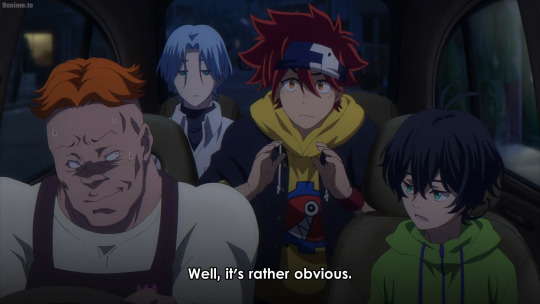
Even when he’s been clearly found it, he still tries to deny that he and SHADOW are the same person. Miya even uses this to coerce Hiromi into helping him and the boys:

I don’t think it’s a stretch to say that the separation between Hiromi and SHADOW can be interpreted as a metaphor for being in The Closet. As SHADOW, he leads a secret life, one characterized by an tight-knit underground community with a vibrant night scene, where he behaves in ways typically frowned upon by larger society. He worries about being found out and judged by the people close to him.
But in Ep 4, the walls of his Closet begins to come down, or in this case is literally imposed upon by other members of his community, by its younger members, who don’t feel the same need to hide their passion for skateboarding or lead the same kind of double life.
We then see the line between Hiromi and SHADOW begin to blur.
He becomes less of an antagonist, and instead the audience sees him become a mentor and “mother hen” figure for the younger skaters. Later on in Ep 4, we see him casually interacting with the other protags in full SHADOW mode, not as an “anti-hero” but as a friend. In Ep 6, he acts as a babysitter for the kids, and we see him totally comfortable appearing both in an out of his SHADOW persona throughout their vacation.
And I think that this gradual convergence of Hiromi and SHADOW will culminate in this tournament arc.
There’s something more personal that’s driving SHADOW to do well in this tournament. It’s not just for bragging rights or his pride as a skater, but the results of this tournament is going to have some kind of greater impact on Hiromi’s personal life. Personally, my theory is that Hiromi is using this tournament to prove to himself that he’s worthy enough to ask his manager out on a date.
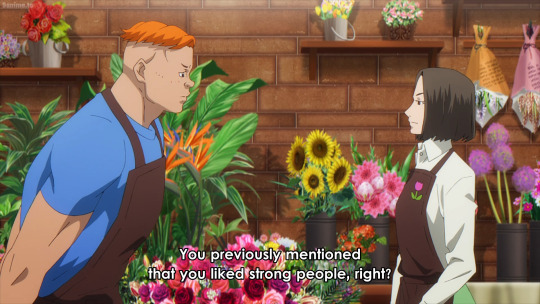
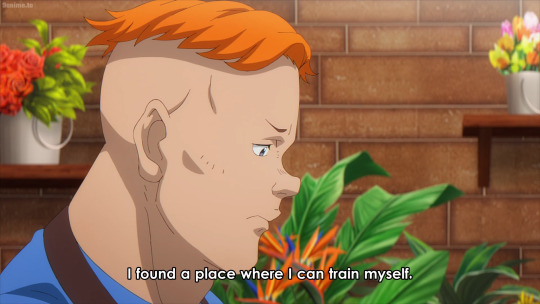
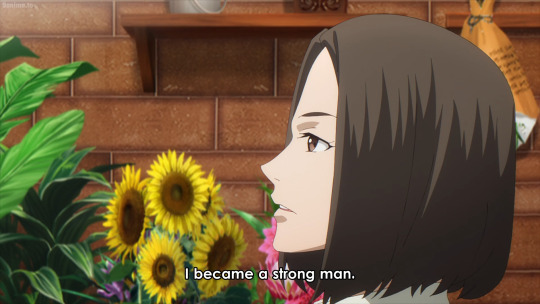

Hiromi is no longer compartmentalizing, his two lives are overlapping and influencing each other. Recall the essay quote I cited earlier:
The closet... is the space in which queer identities build themselves up from “disused pieces” and attempt to discover the strength needed for presentation to the world... of potentiality and actualization.
This is exactly the case for Hiromi. Through skating, he is piecing together the disparate parts of him such that he can present himself to the world as a more unified and confident being.
And the show presents the very skating community that Hiromi has been working so hard to keep separated from his personal life- Reki, Langa, Miya, Kaoru, and Kojiro- as the catalyst for that becoming.
That, my dear readers, is queer coding if I ever saw it.
But there’s probably gonna be people claiming something along the lines of “But SHADOW can’t be queer rep because he’s Straight!” And I assume that’s because he shows romantic interest in his female manager.
First of all, Bisexuality. Also Ace/aro-spec people. And second of all, SHADOW is Hiromi’s drag persona.
And before anyone can say anything about how Hiromi can’t do drag because he’s straight (assumption) and cis (also an assumption) uhhhh no, fuck you.
Drag didn’t start with RuPaul’s Drag Race, that’s just how it got mainstream. And it’s also how it got so gentrified and transphobic. You heard me. But anyway.
Drag is, and has always been, first and foremost about exaggerated, and oftentimes satirical, gender presentation and performance. It’s about playing with gender norms through artistic dress and theater, not so much to do with sexuality or gender identity.
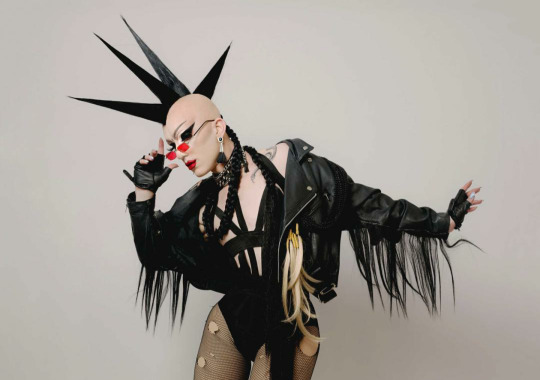
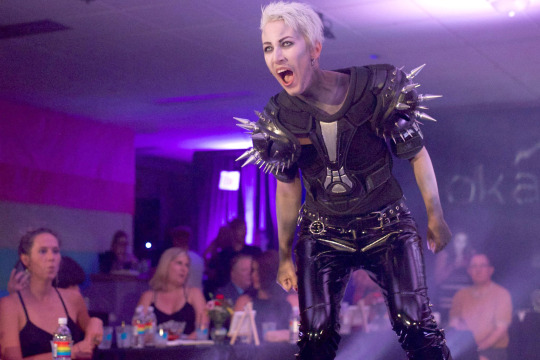
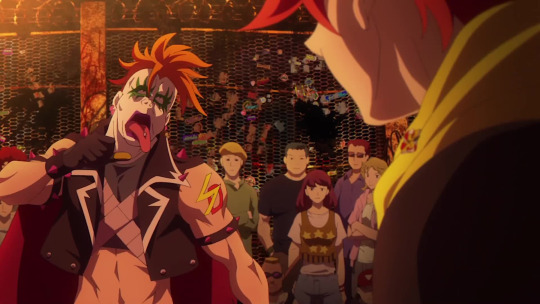
Literally, what’s the difference here?
SHADOW is a persona of exaggerated masculinity with a punk aesthetic. Regardless of his sexuality or gender identity, Hiromi’s gender performance as SHADOW is drag- that makes him queer representation, change my fucking mind.
Queerness is more than same-sex romance, and by extension, good queer representation is not limited to canonized gay ships. The very word Queer, in it’s ambiguity, is meant to encompass the richly unique experiences of everyone within the LGBTQ+ community.
In my opinion, Queer =/= Gay. I mean, they’re colloquially the same yes and even I use them interchangeably. But for the purpose of this post, they’re not the same, and that’s to argue that Hiromi/SHADOW’s lack of acknowledgement as queer rep illustrates a larger issue of exclusion within fandom.
I mean, this is something we all kinda been knew, but in the case of Sk8 specifically, there are a two main reasons why I think Hiromi is rarely acknowledged as queer rep.
1. He’s not shippable with another male character
Fandom favors mlm ships when it comes to what’s considered good queer rep. And the ultimate mark of good queer rep is explicit acts of romance or intimacy between two male characters. Unlike with any of the other characters in the show, we can’t point to Hiromi and automatically clock him as gay, especially because he expresses romantic interest in a woman.
So by default, he’s less popular, because “Ew Straight People” amirite /s.
2. He’s not attractive
This is really interesting, because like JOE, Hiromi is a beefcake.

But fans don’t thirst over him the same way they do over JOE. Granted, the show really plays up JOE’s muscles in a very strip-teasey way that literally encourages viewers to find him attractive. By contrast, Hiromi is pretty much covered head to toe and he paints his face in theatrical makeup- the point is to look scary, not attractive.
In essence, even though Hiromi engages in “queer behavior” through his SHADOW persona, his queerness isn’t palatable.
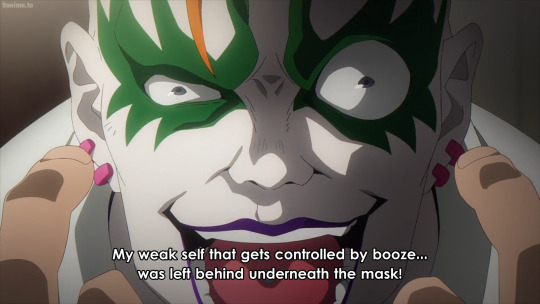
But I also think there’s some pretty insidious undercurrents of fetishization going on here, of both Asian people AND gay men. Which is... a whole other thing I really don’t have the capacity to unpack completely.
But basically, Hiromi doesn’t fit into any of the popular BL archetypes so he’s less likely to recognized as Queer. Relatedly, he’s also less often subjected to a fetishistic gaze as other characters. I mean...

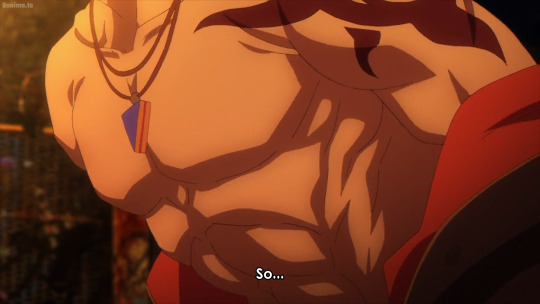
So again, fans just don’t find him as appealing. Attractive characters are always more popular than ugly ones.
And I’m sure there are a lot of people who just don’t care for Hiromi’s personality, that’s fine, he does act like an asshole sometimes. But this post is meant to illustrate that queer rep takes multiple forms, and unfortunately I think a lot of media just tends to fall back on stereotypical portrayals of queer people for the sake of broader appeal. And by consequence, the fandom’s idea of what constitutes queer rep narrows to same-sex romance, usually between two cis gay men.
With the release of Ep 9, I know a lot of people queer people are going to find representation in the Kojiro’s whole “unrequited love” thing. But personally, I feel more represented by Hiromi, his journey of self-acceptance and subversive relationship with gender- that’s what resonates with me as a trans person.
And I think it’s important to see that kind of less palatable type of queer representation more acknowledged in fandom, and in Sk8′s fandom especially, because I know the demographics of this fandom lean heavily queer.
But that’s all for now, lemme know what you guys think :)
#if there are typos forgive me i'm tired#i've been sitting on this take for a number of weeks now#i rlly hope i'm big braining rn#and not just like#yelling into a void#i love hiromi#yall Sleeping on my mans#hav u seen his leather clad ass???#bodacious#sk8#sk8 the infinity#sk8 theory#sk8 meta#sk8 spoilers#sk8 shadow
185 notes
·
View notes
Text
TEACHING MOMENT FOR ALLIES: PLEASE UNDERSTAND THE DIFFERENCE BETWEEN "TERF-Y" AND "TRANSMISOGYNIST"
(TL;DR: "Transmisogyny" is the way in which trans women experience the intersection of transphobia and misogyny, inextricable from one another and mutually constitutive, and also describes the systems of social power and violence that produce this experience; "TERFism" (trans-exclusionary radical feminism or sometimes trans exterminationist radical feminism) is a particular ideology and movement that is primarily structured by its transmisogyny, but which is definitely not the only manifestation thereof. The two are not interchangeable, and learning to recognize TERFism insofar as it is distinct from other kinds of transmisogyny will make you a better ally/accomplice to trans women. Scroll down for a mini field guide.)
I was at this conference over the weekend, and at one point I was talking with someone else about the sessions. One of them was lead by a Sister of Perpetual Indulgence ("drag nuns"; one of the surviving elements of older-school spectacle theater LGBTQ+ activism) and the person I was talking to expressed interest in the session, but (quote as best I can recall) "I get uncomfortable with drag queens because some of them are pretty TERF-y".
I think what this person was getting at was that drag queens (and sometimes "drag culture" more broadly, especially where it has become more commodified and whiter) often enact misogyny (and transmisogyny especially--plus racism, ableism, etc. etc. in other ways).
I appreciate this acknowledgment. I have a really troubled relationship with drag queens and drag generally because of the transmisogyny I've experienced in that context. BUT--and I understand that this might seem pedantic, but please hear me out--but, the word needed in this situation is not "TERF-y", it's "transmisogynist" (or "transphobic", but TBH I think the gender specificity here is important).
I say this because TERFism is a particular ideology with a particular history defined largely by its rejection of and hatred toward trans women--but that history and that ideology are very, very rarely the things that make drag transmisogynist. Basically, all TERFs are transmisogynist, but not all transmisogynists are TERFs.
So, for example--TERFs often argue that trans women are "appropriating womanhood" because we did not experience (cis) girlhood, which is, by their argument, a necessary prerequisite to put one in the social category of woman. They sometimes describe our identities and presentations as "womanface" (akin to blackface) because of this. It probably doesn't surprise you that this analysis does not favor drag queens either (although perhaps ironically, I think it's actually a reasonable analysis of cases where drag queens are mocking femininity or playing into misogynist stereotypes for humor value--though to be clear, "womanface" is a troubled concept given the history here is not in any meaningful way similar to blackface).
On the contrary, in my experience, transmisogyny coming from drag communities is rarely based on principle or any real gender analysis. It's mostly a reflection of general societal transmisogyny, with the same tropes (using "man in a dress" as a punchline, treating "passing" trans women as deceptive, rampant use of slurs like "shemale" and "tranny", etc.), distinguished only in that participants often feel a stronger sense of entitlement to those words, tropes, and joke. TERFs may use some of the same ideas (the "deceptive/predatory tranny" is a big archetype for them wrt lesbian trans women) but the drag community's usage does not generally add up to anything bigger, other than one more voice in the background noise of societal transmisogyny.
Now, my understanding of this was hard-won through decades of life as a trans woman, as well as no small amount of formal education on the subject. Obviously, I don't expect others to go through that, so here's a brief field guide to spotting TERFs (note: if you want counterarguments or ways to address some of these views, feel free to message me, but it'd take FOREVER to address every single one here)...
.
.
.
.
-A FIELD GUIDE TO IDENTIFYING TERFs-
-SOCIALIZATION DISCOURSE-
TERFs typically argue that trans women are "socialized male", i.e. that we were raised as boys/men and that we internalized messages associated with that (entitlement to women's bodies and sexual aggressiveness, dominance in conversations, lack of stigmatization of our bodies).
This also pops up in criticisms of trans women's behavior, where if we are loud, angry, or assertive, those behaviors are read as "mannish" or "masculine" and as such as evidence of our "male socialization", because women and girls are often taught not to express themselves in those ways and are punished for doing so.
This is pretty specific to TERFism--general transmisogynists rarely analyze quite this deeply.
-SEX ESSENTIALISM-
TERFs typically argue that women's oppression is located specifically in (cis) female bodies. They'll often argue that gender isn't real (or e.g. that "gender identity" is just internalized sex/gender role stereotypes), but sex is, and that because trans women are not (cis) female that we do not experience misogyny (even if we "pass"). Sometimes this argument takes on a spiritual or mystical angle, saying that trans women have "male energy" or auras. This is often also applied to trans men, who they generally treat as women "lead astray" by trans politics or the allure of male privilege.
The particular analysis above--connecting misogyny specifically to cis female embodiment--is generally connected to TERF thought (but not always! I think, for example, some of the pushback to trans women's frustration about the whole pussy hat thing came from a not-intentionally-TERFy inability of some cis feminists to imagine or connect how trans women experience violence as women, and a strong sense that regulation of and violence against their (specifically cis) female bodies was a necessary element of experiencing "womanhood"), but sex essentialism and biological essentialism itself shows up all over. Liberal feminist thought, for example, often uncritically reproduces the sex/gender distinction, constructing trans women as "male women" in the process, and "really a man!" is like basic Geraldo-level shit.
-PENIS STUFF-
One other manifestation of sex essentialism is hyperfocus on genitals--TERFs sometimes treat trans women's penises as basically purpose-built tools for raping (cis) women (or, more specifically, they argue that all penises are rape machines and never miss a chance to remind trans women that our dicks are weapons, too). Especially when they focus specifically on trans women's genitals (and not cis men's), they overlap a lot here with far right Christo-Fascist types (see: Women's Liberation Front filing a joint amicus brief with Focus on the Family in the Gavin Grimm case), so hyperfocus on our genitals is transmisogynistic, but not necessarily TERFism. This trope also gets played for comedy (Ace Ventura, The Hangover 2, Family Guy) or drama (The Crying Game, Silence of the Lambs) all the time.
-MALE PRIVILEGE-
Between the socialization and embodiment stuff above, TERFs almost always argue that trans women had and benefited from male privilege before coming out or transitioning, and will often argue that we continue having it even after we've done so. This is the most common argument for the existence of "women's spaces" that exclude trans women (but often include trans men!)--that they are for "people who have never experienced male privilege", or sometimes they just overtly state "this space is only for people assigned female at birth". These two, especially when treated as though they are synonymous with "women", is explicitly TERFy.
Like socialization, this is typically an argument used by TERFs because general transmisogynists just aren't that engaged in feminist analysis and aren't thinking about the operation of male privilege in their day to day lives.
-SLURS, PRONOUNS, AND LANGUAGE-
In my experience, TERFs are less likely to use slurs ("shemale", "tranny", etc.) or derogatory terms ("trap", "he-she", etc.) than general transmisogynists, in part because they know optics matter, and slurs will typically push leftist people away. That doesn't mean they never do it, or that they necessarily care about leftists (see above, WoLF cozying up with FotF), but they do present themselves as "radicals" and cultivate that image with a veneer of respectability. Somebody using slurs really openly PROBABLY isn't a TERF, but might be.
What they will do, however, is aggressively misgender trans people, especially trans women. Frequently they will refer to us as "males" to rhetorically class us alongside cis men (or sometimes just use "men" with an understanding that they're including us), and will use he/him/his pronouns when talking about us. Other times--especially in spaces where they are cultivating that veneer of Legit Respectable Leftism, they will either use no pronouns for us at all, or only use "they". Some of them, in some spaces, will use correct pronouns, especially for trans women who support their politics and ideology. Obviously, though, misgendering happens all the time, and just misgendering a person is obviously transphobic, but not necessarily TERFy.
For obvious reasons, few TERFs identify with the label "TERF", and may argue that "TERF" is a slur. They may identify themselves simply as "radical feminists", or use other euphemisms ("gender critical" is a very common one) that distance themselves from the reputation that has been attached to TERFism (and to some extent, radical feminism more generally). For the most part, only TERFs think TERF is a slur. There are, however, trans-inclusive radical feminists that are determined to remediate and reclaim the "radical feminist" label, even though it fell out of favor for a while, so keep that in mind.
-OTHER RANDOM NOTES THAT DON'T FIT ANYWHERE ELSE-
Sometimes I use TWERF instead of TERF--it changes it to Trans Woman-Exclusionary/Exterminatory Radical Feminism". I do this because historically TERFs have primarily targeted trans women and CAMAB NB folks for violence in ways that they have not targeted trans men or CAFAB folks generally. I think this is an important history to remember, but I use TERF throughout this piece because it's more familiar to people.
As above, Trans-Inclusive Radical Feminism is a thing that does exist. I know radical feminists who oppose TERFs (in fact, the term "TERF" originated with radical feminists trying to push transphobes/transmisogynists out of their orgs and spaces). I considered myself a radical feminist for quite a while. That doesn't mean you can never use "radfem" pejoratively (especially, I would never tell other CAMAB women how to talk about their experiences of violence) but you should be careful about it, because IMO that demonization of radical feminism is how we ended up in a liberal feminist pit, just trying to tread water. Part of how TERFs recruit is that they're a way to escape this hell of Lean In corporate apologism and must-defend-Kellyanne-Conway liberal bullshit. Part of keeping their ranks from swelling as people realize how late-stage capitalism has turned mainstream feminism into a marketing exercise is to open up other options for them--womanism, transfeminism, and yes, TIRFism.
As I said way back, TERFism is structured around its transmisogyny. It doesn't offer a coherent gender analysis that even begins to reflect the reality of trans women's experiences because as time wears on and it continues to solidify as a sect of feminism, it more and more has to structure itself around societal transmisogyny for support. The problem is that societal transmisogyny is a VERY steady, reliable base on which to build your shit, because society fucking hates trans women and has for centuries, even millennia. So even though TERFism is essentially ideologically incoherent, there is intense social reward for participating in transmisogyny, no matter how you come by it. Remember that if you're thinking of trying to argue a TERF into reasonableness: for them, there is a reward above and beyond intellectual satisfaction to be gained by their bigotry: the creation of a trans woman underclass ripe for exploitation (especially sexual exploitation) and who attract a great deal of men's sexual and relational violence in society. In other words, you're not likely to succeed.
-CONCLUSION-
Obviously not all TERFs will conform to what I've said above. Sometimes people will say or do TERFy things without being TERFs (I'd argue that Chimamanda Ngozi Adichie's comments last month were TERF-y in their emphasis of socialization, but that she herself is not a TERF). But the important take away here is that transmisogyny is different from TERFism, and it exists in the bedrock of our society.
Being able to distinguish TERFs from other kinds of transmisogynists is an important tactical ability, if you want to work alongside trans women to dismantle the systems that oppress us. Just as Mike Pence's misogyny is different from GamerGate misogyny, and just as both require unique approaches even if they are obviously aspects of the same struggle, transmisogyny is a many-headed beast, some more difficult to tackle than others. TERFs, I can promise you, are a hard one to tackle. Casting all transmisogyny as TERFism makes for both a pessimistic vision (it's gonna be hard to root out) and an overly optimistic one (in reality, transmisogyny looks like many different things, and no one strategy will work for all of them). Listening to trans women and being familiar with our history and movements will make you much more effective working alongside us.
#transmisogyny#transphobia#trans#trans womanhood#lgbt#lgbtq#ally#allyship#ppl on facebook seemed to find it helpful
62 notes
·
View notes